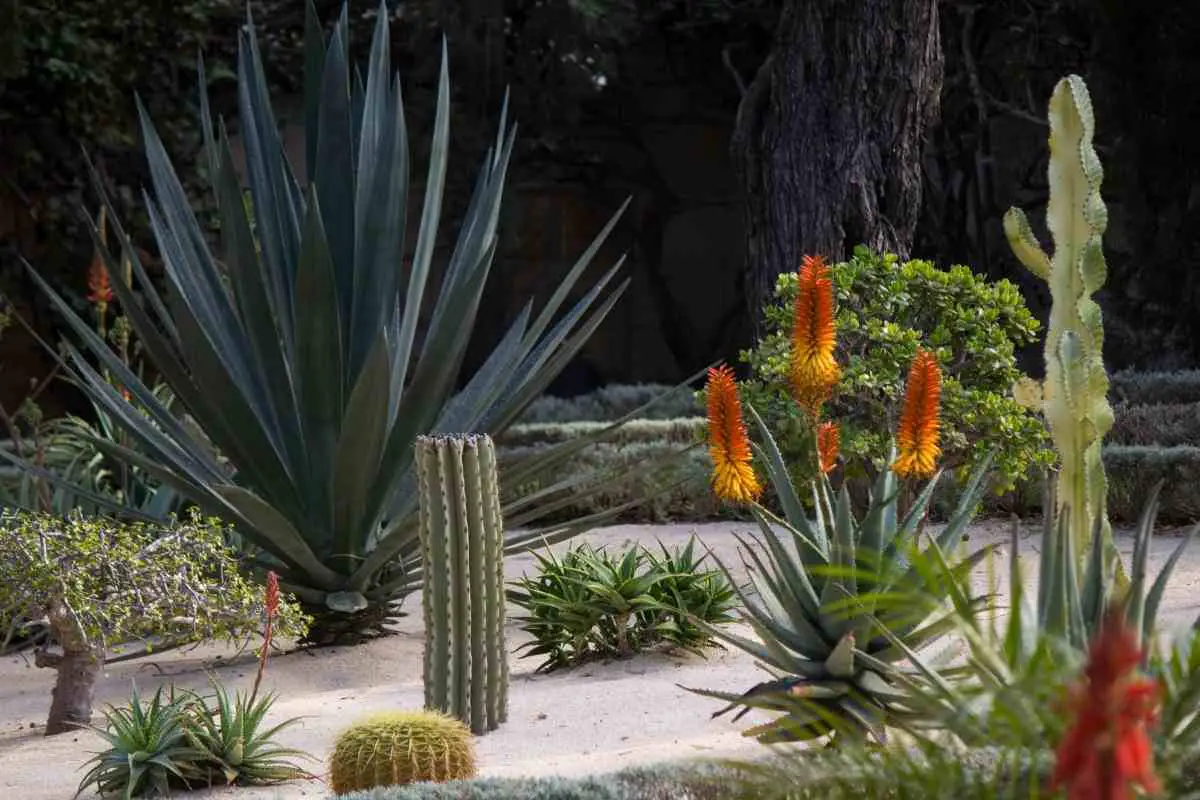Succulents are not only cute and quirky.
These fleshy drought-hardy plants can achieve great heights, easily comparable to many trees and shrubs.
If you are looking for a statement plant to liven up your garden or become a conversation starter in your home, these 10 beautiful tall succulents for the home and garden could be just right for you.
Tall Succulents Guide
Succulents
A succulent is a plant that stores water and has thick or swollen leaves and stems.
Height & Space
The plant can grow tall, so make sure you have enough space. The taller they get, the more shade they can produce for you if used in an outdoor space.
Succulents are great for a home garden as they will grow tall and large, so having ample room outside in the full sun works best.
Remember, these can get ten feet tall! So having these in a container in your kitchen or office may be difficult unless you have zones set aside where they can grow tall on their own.
Color
During the blooming season, the color of the succulents can really shine through their leaves and branches.
Plant Care
Plant care is important because these tall succulent plants can store water. They do seem to be more forgiving if you skip a day watering them. Just don’t make a habit out of it.
10 Large succulent Plants for the home and garden
Add some vertical interest to your home or yard with these ten remarkable succulents that achieve heights (or lengths) of a meter or more.
1. Foxtail Agave

- Latin name: Agave attenuata
- Alternate names: Lion’s Tail Agave, Swan’s Neck Agave, Century Plant
- Native to: Mexico
- Maximum height/ length: 1.5 meters
- Maximum spread: up to 2.5 meters
- Growing zone: 9b to 11b
- Suitable for indoors? Yes
- Toxicity: none
Description
The foxtail agave is a member of the agave family of plants that are used to make Tequilla and agave nectar.
This succulent produces long, tongue-like pale green leaves that protrude in a rosette from its thick stem.
In the summer growing season, when conditions are right, it can produce a central flower stalk with yellow flowers.
It takes over a decade to reach its maximum height of 1.5 meters.
Care tips for the foxtail agave
The foxtail agave love light and a full sun position. Like all succulents, the water requirements are minimal.
From Experience – Plant foxtail agave in a slightly acidic, well-draining, sandy soil, and repot your agave every 2 years as it grows.
Prune this succulent by removing the basal leaves.
2. Madagascar Palm
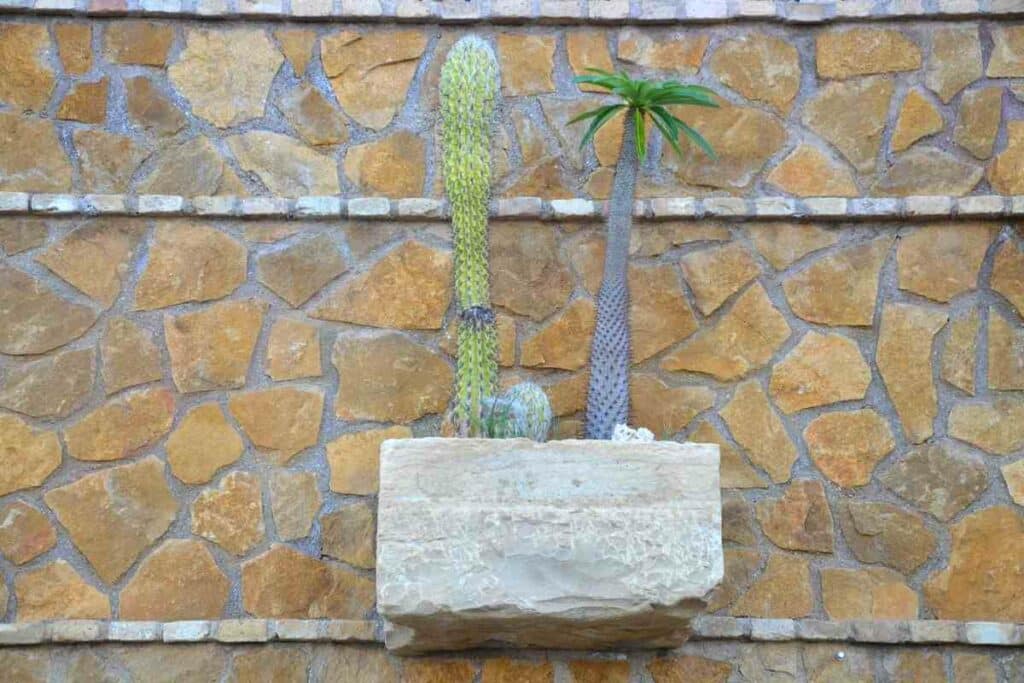
- Latin name: Pachypodium lamerei
- Alternate names: Pachy, Summer-blooming clubfoot, Three-spined clubfoot, Ghost men plant.
- Native to: Madagascar
- Maximum height/ length: 4 meters
- Maximum spread: up to 2.5 meters
- Growing zone: 9 to 11
- Suitable for indoors? Yes
- Toxicity: toxic and sharp spines are harmful to pets
Description
The Madagascar palm is not a true palm but a succulent that looks the part.
This makes it a great houseplant, as it is just as low maintenance as other succulent species.
P. lameri has a tree-like appearance with a trunk-like main stem and side stems that carry spiny leaves and clusters of white flowers in the summer.
This tall succulent can grow up to 6 feet tall indoors and as much as 20 feet outside.
Care tips
The Madagascar palm thrives in full sun and will need good exposure to sunlight if kept indoors.
Pot it in cactus soil that is fast-draining, or well-drained sandy soil.
It only requires watering when the soil completely dries out; hold back water in the winter when it becomes dormant.
Feed at the beginning of spring with a liquid fertilizer.
3. String of Pearls

- Latin name: Curio rowleyanus / Senecio rowleyanus,
- Alternate names: “String-of-beads”, “string of watermelons”
- Native to: Southern Africa
- Maximum height/ length: 1 meter
- Growing zone: 9 to 12
- Suitable for indoors? Yes
- Toxicity: mild
Description
Curio rowleyanus is instantly recognizable by its pearl-shaped leaves that have a diameter of approximately ¼ inch (6 millimeters).
It produces long, trailing stems covered with these ‘pearls’ that can exceed 1 meter (3 feet in length). A great choice for hanging baskets, where you can show off the trailing stems.
In Namibia, where it originates, it spreads and hangs, and this dramatic appearance makes it attractive as a houseplant.
It flowers annually in the summer, producing small, white color flowers that smell of cinnamon.
Care tips for a string of pearls
Maintenance of this beautiful hanging succulent is easy.
It prefers a bright position that is away from direct sunlight and warmth with temperatures no lower than 50°F (10°C).
Water Very Lightly – Only when the soil of your string of pearls dries out. It should only be fed during its growing season with a dilute liquid feed added to the waterings.
4. Soap Tree Yucca
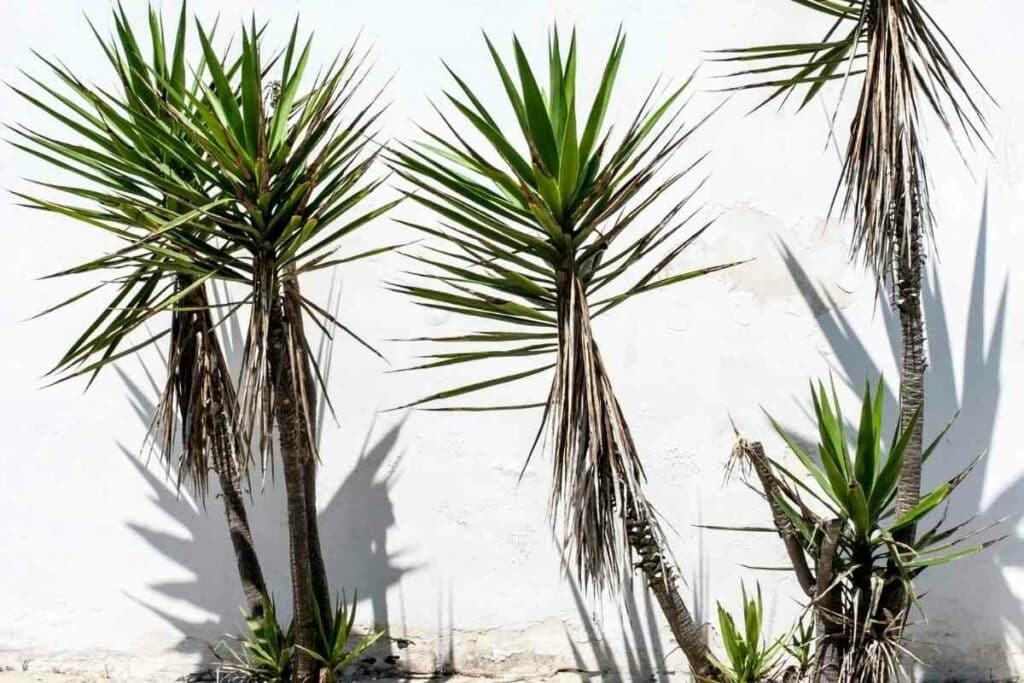
- Latin name: Yucca elata
- Alternate names: soapweed, palmella, soaptree
- Native to: Southwestern US and Mexico
- Maximum height/ length: 4.5 meters
- Maximum spread: up to 1.5 meters
- Growing zone: 6 to 11
- Suitable for indoors? Yes
- Toxicity: none
Description
This tree-like plant is a popular tall succulent that can be cared for indoors or outdoors if the temperatures are suitably warm.
With the right conditions, the soap tree yucca can achieve heights of over 14 feet (4.5m).
There are many varieties or subspecies of this popular plant which has a long brown cylindrical trunk and stems that give rise to whorls of long slender leaves.
The soaptree yucca can produce white bell-shaped flowers and long brown color capsular fruit that is filled with black seeds.
Care tips for the soap tree yucca
Soap tree yucca is hardy enough to grow in temperate climates and survive cold winters.
Plant this tall succulent in alkaline, well-draining soil in a full sun position. If you want a tall plant, you’re going to have to wait.
This yucca grows very slowly, about an inch per year!
5. African Milk Tree

- Latin name: Euphorbia trigona
- Alternate names: good luck cactus, good luck cactus, candelabra cactus, friendship cactus
- Native to: Central Africa
- Maximum height/ length: 3 meters
- Growing zone: 9b to 11
- Suitable for indoors? Yes
- Toxicity: blistering with skin contact and digestive tract irritation if ingested
Description
The African milk tree is one of the best plants to choose if you want a fast-growing tall succulent for your home or garden.
This striking African succulent can reach heights of up to 10 feet (3 meters+).
Brace yourself for speedy growth that can exceed 2 feet (60 cm) per year.
This glossy dark green succulent has an upright ridged mainstem with upright side stems coming off it.
The ridges also carry thorns and thin teardrop-shaped leaves.
Care tips
This succulent is very hardy and can tolerate cold winters with temperatures as low as 27 °F (−3 °C). It also propagates well and can be established quickly from stem cuttings.
Plant your African milk tree in loamy well-drained soil. It loves the sun, so plant it outdoors in a full sun position or place your indoor plant by a sunny window.
Plant care is important. Without the right amount of sun and too much shade, it will not grow and could die out.
Limit watering in its winter dormancy and feed once or twice during the growing season.
Heads Up! Remember to keep pets and children away because of its toxicity and shark thorns.
6. Fishhook barrel cactus
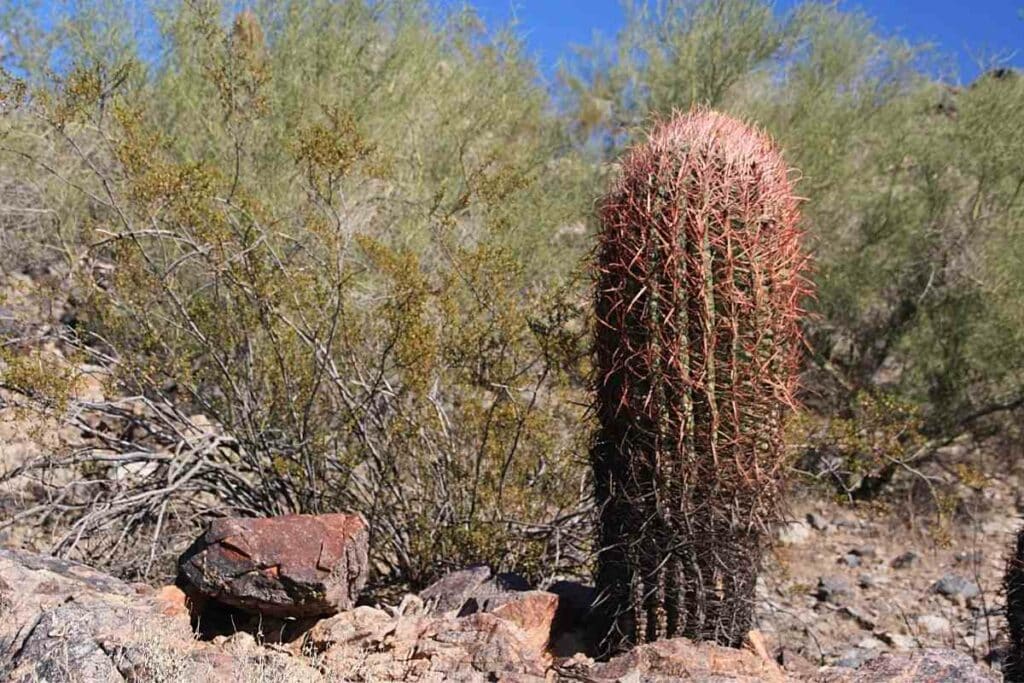
- Latin name: Ferocactus wislizenii
- Alternate names: Arizona barrel cactus, Candy barrel, Southwestern barrel cactus, Candy barrel cactus, Compass Barrel.
- Native to: Southwest US and Mexico
- Maximum height/ length: 2 meters
- Maximum spread: up to 0.9 meters
- Growing zone: 9b to 11b
- Suitable for indoors? Yes
- Toxicity: yes – irritant sap
Description
This barrel-shaped, cartoon-like tall cactus is a native of desert regions in states like Arizona and Texas.
Areoles with sharp straight and hooked spines punctuate its 25 prominent ribs. It is incredibly long-lived and can easily survive for a century or more!
The fishhook barrel cactus is a slow grower but can achieve a maximum height of 2 meters.
In warm and sunny conditions, you’ll be treated to an annual display of orange-red or yellow flowers.
Care tips
You can grow these stout and rather fierce-looking tall succulents indoors or outdoors.
It is drought and disease-resistant. They need well-drained sandy soil and full sun to thrive.
7. Organ Pipe cactus
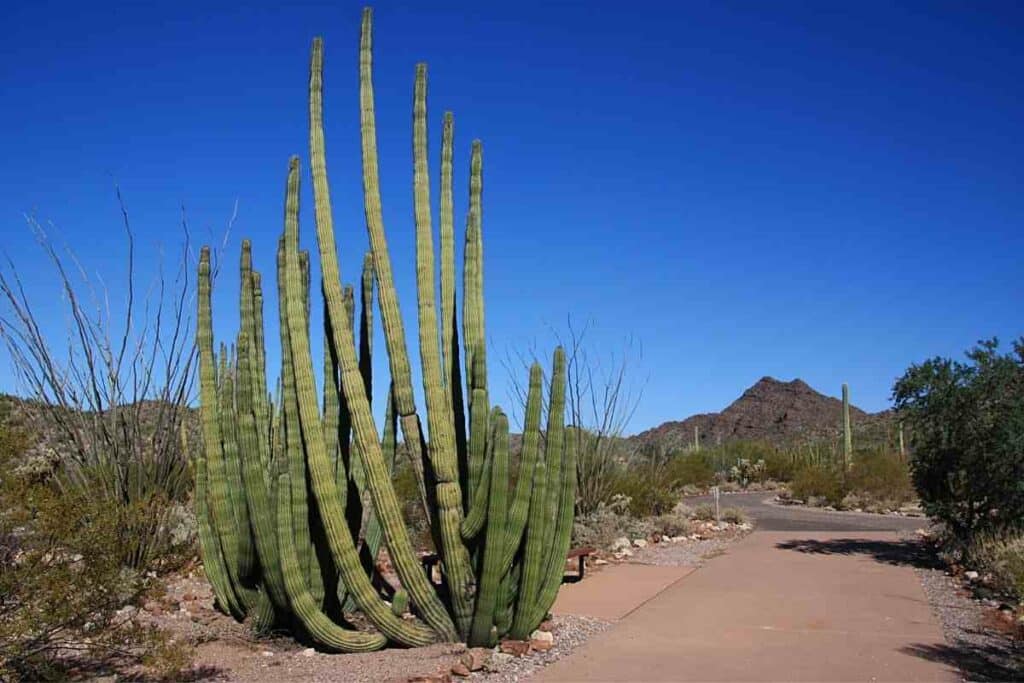
- Latin name: Stenocereus thurberi
- Alternate names: pitaya dulce, sweet pitaya, sweet cactus fruit, Mehuelé, Órgano Marismeña.
- Native to: Mexico
- Maximum height/ length: 5 meters
- Growing zone: 9 to 11
- Suitable for indoors? Yes, but outside is preferable.
- Toxicity: none
Description
This large cactus is named because it looks like a pipe organ with multiple narrow vertical stems that rise from its short trunk.
The ribbed and spiny stems can grow to a height of over 16 feet (5 meters) and thicken up to 6 inches (15cm) in diameter.
The organ pipe cactus is relatively slow-growing, taking 150 years to reach maturity.
As It Ages – It produces white, funnel-shaped flowers. Interestingly, the flesh within the organ pipe cactus is edible and sweet, tasting like watermelon.
Care tips
You can grow the organ pipe cactus outside in a suitable climate.
It prefers sandy, gritty soil that is fast-draining. Unglazed terracotta is ideal if you grow this cactus in a pot as it prevents the cactus from becoming waterlogged.
You can also keep mini versions of the organ pipe cactus as houseplants.
Keep watering to an absolute minimum and add a diluted feed once or twice during the plant’s growing season.
8. Snake plant
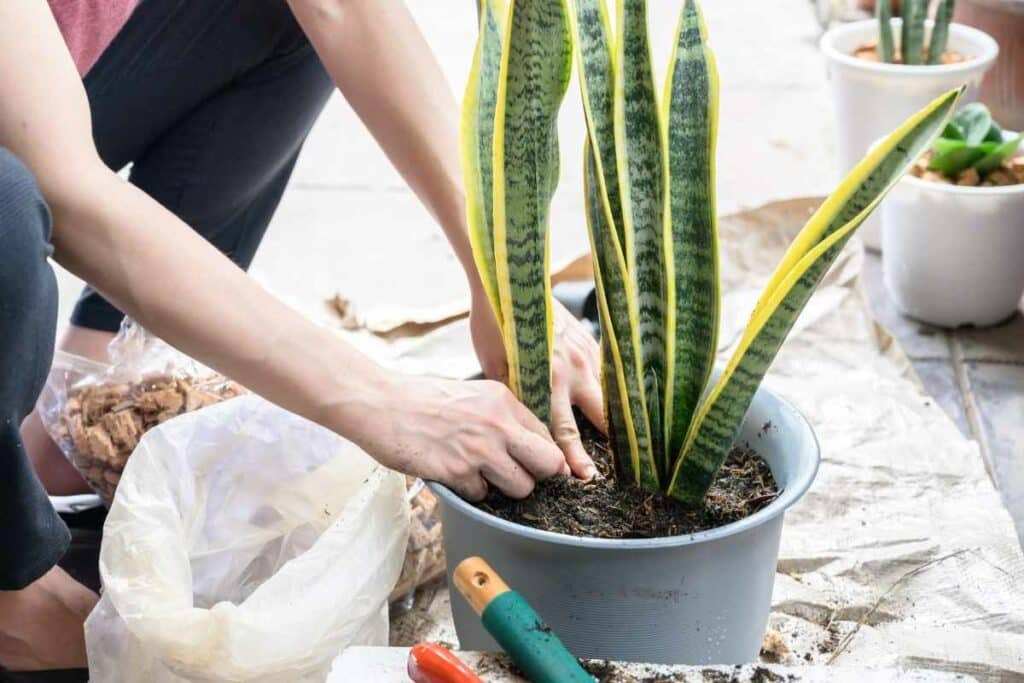
- Latin name: Dracaena trifasciata
- Alternate names: viper’s bowstring hemp, Saint George’s sword, mother-in-law’s tongue, Sansevieria trifasciata.
- Native to: West Africa
- Maximum height/ length: 3.5 meters
- Growing zone: 9b to 11
- Suitable for indoors? Yes
- Toxicity: none
Description
The snake plant is a classic evergreen houseplant known for its banded deep green or variegated tongue-like stiff leaves that grow from a basal rosette.
The leaves will grow and grow, achieving lengths of up to 3 feet (1 meter) and an overall height that can exceed 12 feet.
You can choose from over 70 varieties of snake plants that originate from Africa.
They are known for their unusual properties, such as air purification, which makes them a popular house plant. It flowers rarely, producing greenish-white flowers.
Care tips
Despite its dramatic appearance, the snake plant is one of the lowest maintenance plants around and can withstand even severe neglect.
The snake plant grows quickly from cuttings and thrives in even low light.
Plant in a free draining soil to prevent root rot.
It needs very little water and tolerates being parched in the winter. You can feed the snake plant infrequently with a general-purpose fertilizer.
9. Hedge cactus
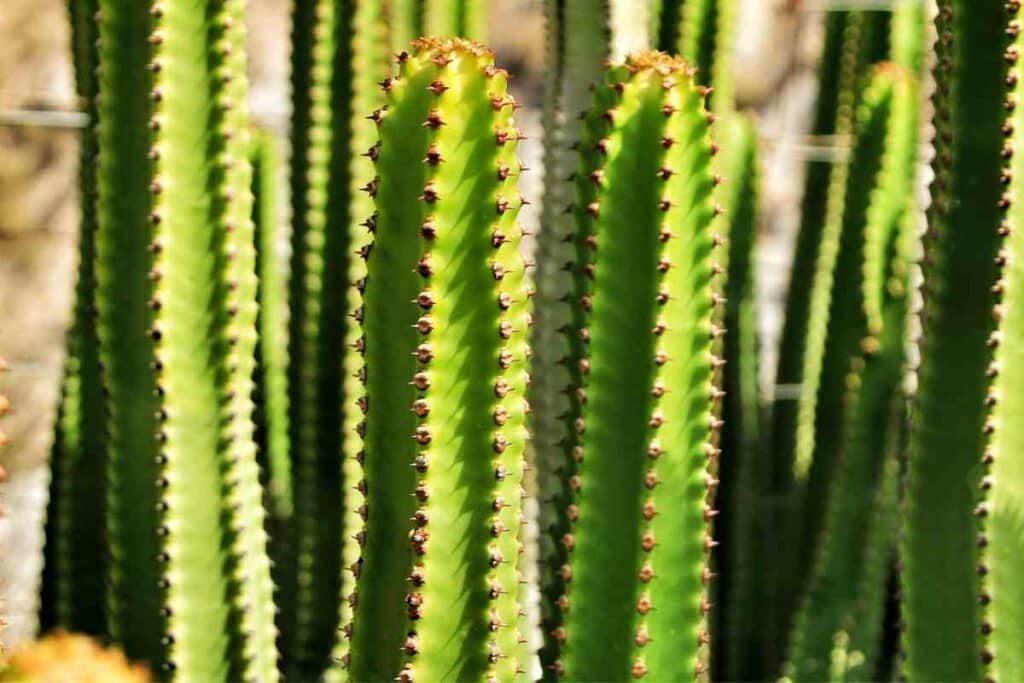
- Latin name: Cereus repandus
- Alternate names: Cereus peruvianus, kayush, giant club cactus, hedge cactus, cadushi.
- Native to: Colombia and Venezuela
- Maximum height/ length: 10 meters
- Growing zone: 9a to 11bas
- Suitable for indoors? Yes
- Toxicity: none
Description
This is a classic ornamental cactus that is popular because of its tall, tree-like appearance.
It can easily exceed 33 feet (10 meters) with cylindrical stems that are 6 to 10 inches in diameter. Its 9 to 10 ribs have areoles with greyish spines of up to 5 cm.
The tallest cactus in the world, at 110 feet (24 meters) is a hedge cactus that is growing in India.
The hedge cactus produces large, cream-colored nocturnal flowers and thornless edible fruits.
In its native environment, local communities use this cactus as a food source and wood material.
Care tips
The hedge cactus thrives in full sun in sandy well-drained soil. It only needs to be watered once every one to two months.
Warmth is essential, as the cactus can freeze in extremely cold weather. It will require protection with fleece during frosts.
10. Aloe Vera
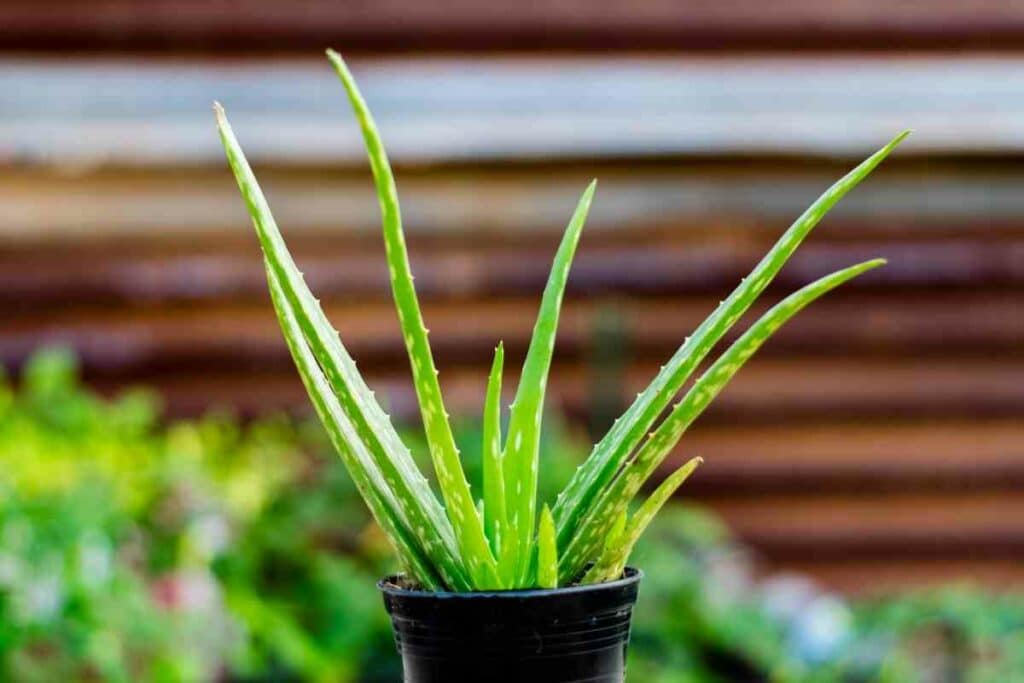
- Latin name: Aloe vera
- Alternate names: plant of life, rokai, sabilla, single bible, Curacao Aloe, Elephant’s Gall, first-aid plant, Kunwar, Ghikumar, Ghi-Kuvar, bitter aloe, Burn Plant, laloi, Lily of the Desert.
- Native to: Tropical regions around the world
- Maximum height/ length: 1 meter
- Growing zone: 8 to 11
- Suitable for indoors? Yes
- Toxicity: none
Description
Aloe vera is prized for its many health benefits, including burn therapy, nutrition, and air purification.
This classic succulent can achieve a height of up to 3.2 feet with fleshy leaves with small white teeth that are up to 35.4 inches (90cm) in length.
It is a moderate grower, taking 3-4 years to reach a mature size with a leaf length of 8 to 10 inches (20 to 25 centimeters)
Care tips
Aloe vera thrives in bright indoor and outdoor locations, but intense direct sunlight can scorch its leaves.
They need little water – just keep the soil damp and allow the plant to dry out between waterings.
If you grow aloe vera in a pot, you will need to repot your plant every two years. It only needs feeding during its growing season.
You’ll find that the plants are easy to propagate from the small offsets that develop at the base of the plant.
Rounding up
Tall succulents make a distinctive addition to your home or garden.
It’s remarkable just how tall these plants can grow.
As with smaller succulents, these plants are easy to care for.
Thankfully, the rate of growth for most succulents is slow and steady, so it will take decades, or even a lifetime, for your succulent to tower over you!
